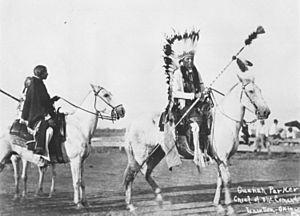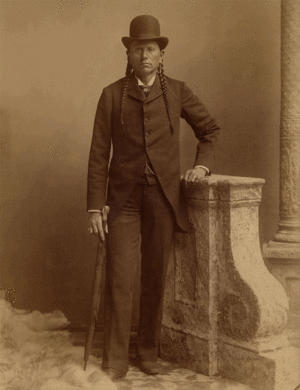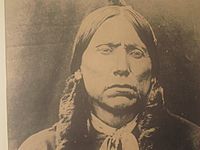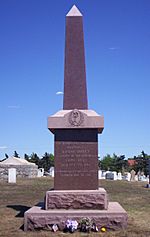Quanah Parker facts for kids
Quick facts for kids
Quanah Parker
|
|
|---|---|
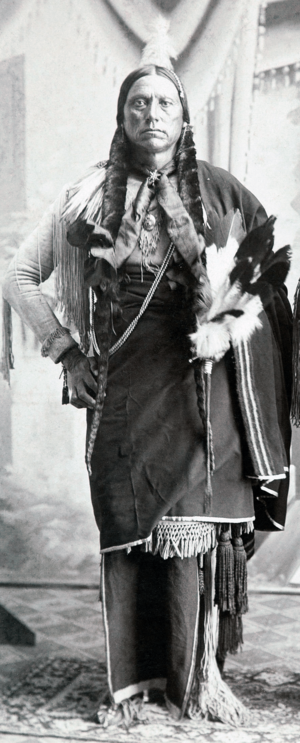
Quanah Parker, c. 1890
|
|
| Personal details | |
| Born | 1845 or (probably, Pecos' birth) 1852 Elk Valley, Wichita Mountains, Indian Territory (Oklahoma) |
| Died | February 23, 1911 Quanah Parker Star House Cache, Oklahoma, U.S. |
| Cause of death | Heart failure |
| Resting place | Fort Sill Post Cemetery Fort Sill, Oklahoma 34°40′10″N 98°23′43″W / 34.669529°N 98.395336°W |
| Spouses | Weakeah, Chony, Mah-Chetta-Wookey, Ah-Uh-Wuth-Takum, Coby, Toe-Pay, Tonarcy |
| Parents | |
| Known for |
|
Quanah Parker (Comanche kwana, meaning "smell" or "odor") was a powerful war leader of the Kwahadi ("Antelope") band of the Comanche Nation. He was born around 1845 and passed away on February 20, 1911. Quanah Parker was the son of Peta Nocona, a Comanche chief, and Cynthia Ann Parker, an Anglo-American girl who was captured by the Comanche when she was nine years old and became part of their tribe.
Quanah Parker became an important leader during the Red River War. He often fought against Colonel Ranald S. Mackenzie. When European-Americans hunted the American bison, which was the Comanches' main food source, almost to extinction, Quanah Parker eventually decided to surrender. He then peacefully led his Kwahadi people to a reservation at Fort Sill, Oklahoma.
Quanah Parker was never chosen as chief by his people through traditional means. Instead, the United States government appointed him as the main chief of the entire Comanche Nation. He became a key representative for Native Americans in the Southwest when dealing with the U.S. government. In his personal life, he became a successful rancher near Cache, Oklahoma. He encouraged his people to adopt some Christian ideas, but he also strongly supported the Native American Church. He fought for the legal use of peyote in their religious ceremonies. In 1902, he was elected deputy sheriff of Lawton. After he died in 1911, the title of "Chief" was replaced with "chairman" for the Comanche people. Because of this, Quanah Parker is often called the "Last Chief of the Comanche." He is buried at Chief's Knoll on Fort Sill. Many places in southwest Oklahoma and north Texas are named after him.
Contents
Early Life and Family
Quanah Parker's mother, Cynthia Ann Parker, was born around 1827. She was part of a large family that settled in east Texas in the 1830s. In 1836, when she was about nine years old, Comanche warriors captured her during a raid on Fort Parker. The Comanche gave her the name Nadua, which means "Foundling." She was adopted into the Nokoni band of Comanches.
Cynthia Ann Parker became a full member of the Comanche tribe. She married a Kwahadi warrior chief named Peta Nocona. He was also known as Nocona, or "Lone Wanderer."
Quanah Parker's grandfather on his father's side was a famous Kwahadi chief named Iron Jacket. He was a brave warrior during earlier Comanche-American Wars. He was known for wearing a Spanish coat of mail (a type of armor).
Quanah Parker was the first child of Cynthia Ann Parker and Nocona. He was born in the Wichita Mountains of southwestern Oklahoma. Quanah Parker once wrote that he was born around 1850 on Elk Creek, near the Wichita Mountains. Some other sources say he was born in Laguna Sabinas/Cedar Lake in Gaines County, Texas.
Cynthia Ann Parker and Nocona also had another son named Pecos and a daughter named Topsana, or "Prairie Flower." In December 1860, Cynthia Ann Parker and Topsana were captured during the Battle of Pease River. After being with the Comanche for 24 years, Cynthia Ann Parker did not want to return to her white family. Topsana died from an illness in 1863. Cynthia Ann Parker died in March 1871.
In the Comanche language, kwana means "an odor" or "a smell." Comanche warriors often chose new, strong names when they became adults. However, Quanah Parker kept the name his mother gave him. He did this to honor her after she was captured again.
Becoming a Leader
After his father, Peta Nocona, died around 1864, a chief named Horseback took young Quanah Parker and his brother Pecos under his care. Horseback taught them how to be Comanche warriors. Quanah Parker became a very skilled warrior.
In the early 1870s, the Native American tribes of the Plains were losing their land to the United States government. After some Kiowa chiefs were captured, the Kiowa, Comanche, and Southern Cheyenne tribes joined together to fight. Colonel Ranald S. Mackenzie led the U.S. Army to gather or defeat the remaining Native Americans who had not moved to reservations.
In 1873, a Comanche man named Isatai'i claimed to be a medicine man. He called for all the Comanche bands to gather for a Sun Dance, even though this was usually a Kiowa ceremony. At this gathering, Isatai'i and Quanah Parker encouraged warriors to raid Texas to get revenge for relatives who had been killed. Other Comanche chiefs thought the buffalo hunters were the real threat. They suggested that if Quanah Parker attacked anyone, it should be the hunters.
A group of about 250 warriors, mostly Comanches and Cheyennes, headed towards a trading post called Adobe Walls. The warriors believed Isatai'i's medicine would protect them from bullets. However, the people at Adobe Walls had heard about the coming attack. The raiders could not break through the thick walls of the trading post. They were pushed back by the hunters' powerful rifles. Quanah Parker's horse was shot, and he was hit by a bullet that bounced off a powder horn. The wound was not serious, and he was rescued.
The attack on Adobe Walls changed how the government dealt with the tribes. It led to the Red River War. This war ended with a big Army victory in the Battle of Palo Duro Canyon. On September 28, 1874, Colonel Mackenzie destroyed the Comanche village at Palo Duro Canyon. He also killed nearly 1,500 Comanche horses, which were very important to the Comanche people.
Life on the Reservation
With their main food source (buffalo) almost gone and constant pressure from the army, the Kwahadi Comanche finally surrendered in 1875. Quanah Parker worked with Colonel Mackenzie and Indian Agent James M. Hayworth to help settle the Comanche people on the Kiowa-Comanche-Apache Reservation in southwestern Indian Territory.
Quanah Parker's home in Cache, Oklahoma was known as the Star House. His tribe was the last group of Comanches to move to the reservation. Quanah Parker was made chief over all the Comanches on the reservation. He proved to be a strong, clever, and capable leader. He made smart investments and became one of the wealthiest Native Americans of his time in the United States.
During this period, Quanah Parker adopted many parts of white culture and took the last name Parker. White people respected him greatly. He even went on hunting trips with President Theodore Roosevelt, who often visited him. However, Quanah Parker did not accept the idea of having only one wife, and he did not follow traditional Protestant Christian beliefs. Instead, he helped start the Native American Church Movement.
Friendship with Samuel Burk Burnett
Quanah Parker developed a special friendship with the Burnett family, especially with rancher Samuel Burk Burnett. This friendship is shown by the gifts they exchanged, like Quanah Parker's war lance, which was a very important item. Their letters show that they admired and respected each other.
Burk Burnett started moving his cattle to an area near Wichita Falls, Texas in 1874. In 1881, he set up his ranch headquarters there. When droughts made grasslands in Texas dry up, Burnett and other ranchers met with the Comanche and Kiowa tribes. They wanted to lease land on the tribes' reservation in Oklahoma.
At first, Quanah Parker did not want to open tribal lands for cattle grazing. But he changed his mind and became good friends with Texas cattlemen like Charles Goodnight and the Burnett family. By 1880, Quanah Parker was even building his own cattle herds with these new friends. In 1884, thanks to Quanah Parker's efforts, the tribes received their first payments for grazing rights on their lands. This is when the friendship between Quanah Parker and the Burnett family grew very strong.
Burnett grazed 10,000 cattle on the leased land until 1902. He truly respected Native American rights. While other cattle owners fought Native Americans, Burnett learned Comanche ways. He passed on his love for the land and his friendships with the tribes to his family. As a sign of their respect, the Comanches gave Burnett a name in their language: Mas-sa-suta, meaning "Big Boss."
Quanah Parker earned the respect of U.S. government leaders as he adapted to the white man's way of life and became a successful rancher in Oklahoma. His large, two-story Star House had a bedroom for each of his seven wives and their children. He had his own simple private room. Next to his bed were photos of his mother, Cynthia Ann Parker, and his younger sister, Topʉsana. Quanah Parker welcomed many important people to his home, both Native American and European American. He considered Burk Burnett his best white friend. He reportedly said, "I got one good friend, Burk Burnett, he big-hearted, rich cowman. Help my people good deal."
Over 27 years, Quanah Parker and the Burnetts shared many experiences. Burnett helped pay for the building of Star House. Burnett also asked Quanah Parker to bring a large group of warriors to parades, like the Fort Worth Fat Stock Show. The "Parade" lance in the exhibit was often carried by Quanah Parker at these public events. Burnett also helped Quanah Parker buy the granite headstones for his mother's and sister's graves. After years of searching, Quanah Parker had their remains moved from Texas and reburied in 1910 in Oklahoma on the Comanche reservation at Fort Sill.
According to his daughter, Wanada Page Parker, her father helped celebrate President Theodore Roosevelt's 1905 inauguration by appearing in the parade. In April 1905, Roosevelt visited Quanah Parker at the Star House. President Roosevelt and Quanah Parker went wolf hunting together with Burnett near Frederick, Oklahoma. During this time, they discussed important matters. Quanah Parker wanted the tribe to keep ownership of 400,000 acres that the government planned to sell to settlers, though he eventually lost this argument. Quanah Parker also asked for help with unemployment among his people. The wolf hunt is believed to be one reason Roosevelt created the Wichita Mountains Wildlife Refuge.
Marriage and Family Life
According to Baldwin Parker, one of Quanah Parker's sons, Quanah Parker married two wives in 1872. His first wife was Ta-ho-yea (or Tohayea), the daughter of a Mescalero Apache chief named Old Wolf. He married her in Mescalero after visiting his Apache allies. After a year, Ta-ho-yea asked to return home because she could not learn the Comanche language. Quanah Parker sent her back to her people.
Quanah Parker's other wife in 1872 was Wec-Keah or Weakeah, the daughter of a Penateka Comanche subchief named Yellow Bear. Although she was first promised to another warrior, she and Quanah Parker ran away together. Yellow Bear chased them, but Quanah Parker eventually made peace with him. The two groups joined, forming the largest force of Comanche Indians.
Over the years, Quanah Parker married six more wives: Chony, Mah-Chetta-Wookey, Ah-Uh-Wuth-Takum, Coby, Toe-Pay, and Tonarcy. A photograph from around 1890 shows Quanah Parker with two of his wives, identified as Topay and Chonie. Quanah Parker had eight wives and twenty-five children (some of whom were adopted).
After moving to the reservation, Quanah Parker connected with his white relatives from his mother's family. He stayed with them for a few weeks. During this time, he learned English and Western culture. He also learned about white farming techniques.
Starting the Native American Church Movement
Quanah Parker is known as one of the first important leaders of the Native American Church movement. Quanah Parker became involved with the peyote religion after he was injured by a bull in southern Texas. He was visiting his uncle, John Parker, when he was attacked and badly hurt. To help him heal, a Mexican curandera (healer) gave him a strong peyote tea.
Quanah Parker taught that the sacred peyote medicine was a special gift to Native American peoples. He said it should be used with water during traditional Native American Church ceremonies. Quanah Parker supported the "half-moon" style of the peyote ceremony. He believed that the Native American Church was a way for Native Americans to connect with their spirituality.
One of Quanah Parker's most famous teachings about the Native American Church was:
The White Man goes into his church house and talks about Jesus, but the Indian goes into his tipi and talks to Jesus.
The Native American Church and Christianity became important for many Native American tribes in the United States and Canada. This happened partly because of the efforts of Quanah Parker and another religious leader named John Wilson. The peyote religion and the Native American Church were not traditional practices for all North American Indian cultures. This religion developed in the 1800s, influenced by events of the time, Quanah Parker's leadership, and ideas from Native Americans in Mexico and other southern tribes who had used peyote in spiritual ways for a long time. Quanah Parker believed that these special plants should only be used for religious purposes.
Death and Legacy
Quanah Parker died on February 23, 1911, at his Star House when he was 66 years old. In 1911, he was buried at Post Oak Mission Cemetery near Cache, Oklahoma. In 1957, his remains were moved to Fort Sill Post Cemetery at Fort Sill, Oklahoma. His mother, Cynthia Ann Parker, and sister, Topsannah ("Prairie Flower"), were also moved there. The words on his tombstone say:
Resting Here Until Day Breaks
And Shadows Fall and Darkness
Disappears is
Quanah Parker Last Chief of the Comanches
Born 1852
Died Feb. 23, 1911
Historian Bill Neeley wrote that Quanah Parker went from being a warrior to a statesman in his lifetime. He also noted that Quanah Parker never lost a battle to the white man and bravely led the Comanche tribe into their new way of life.
Different Views
While many in his tribe praised Quanah Parker for helping to preserve their culture, some Comanches had different opinions. Some felt that he "sold out to the white man" by adapting so much and becoming a rancher. He dressed and lived in a way that some thought was more like European-Americans than Comanches.
Quanah Parker did adopt some European-American customs, but he always wore his hair long and in braids. He also did not follow U.S. marriage laws and had up to eight wives at one time.
Family Reunion
The Quanah Parker Society, located in Cache, Oklahoma, holds a family reunion and powwow every year. The events usually include a trip to special sites in Quanah, Texas, a tour of his "Star Home" in Cache, a dinner, a memorial service at Fort Sill Post Cemetery, a gourd dance, a pow-wow, and worship services. This event is open to the public.
Memorials and Honors
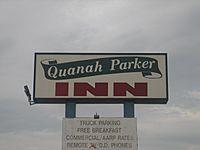
- In 1970, the Star House was listed on the National Register of Historic Places.
- The Quanah Parker Trail, a public art project started in 2010, honors Comanche history in Texas.
- Quanah, Texas, a town, is named after him. When the town was founded, Quanah Parker gave this blessing:
May the Great Spirit smile on your little town, May the rain fall in season, and in the warmth of the sunshine after the rain, May the earth yield bountifully, May peace and contentment be with you and your children forever.
- Nocona, Texas, is named after Quanah Parker's father, Chief Peta Nocona.
- In 1962, Parker Hall, a residence hall at Oklahoma State University, was named after him.
- Parker Hall, a residence hall at Southwestern Oklahoma State University, is also named in his honor.
- The Quanah Parker Trailway (State Highway 62) is in southern Oklahoma.
- Quanah Parker Lake, in the Wichita Mountains, is named after him.
- Quanah Parker Trail, a small street in Norman, Oklahoma, is named after him.
- In Fort Worth, along the Trinity River, there is Quanah Parker Park.
- The Quanah, Acme and Pacific Railway, which started in Texas in 1902, was named after him.
- Quanah Parker Elementary School is in Midland, Texas.
- In 2007, a Texas historical marker was placed near the Fort Worth Stockyards Historic District to recognize Quanah Parker's work as a cattleman and rancher.
- In 2019, an asteroid named (260366) Quanah = 2004 US3 was discovered and named in his honor.
In Popular Culture
- In the 1956 film Comanche, Quanah Parker is played by Kent Smith.
- In the 1961 film Two Rode Together, Quanah Parker is played by actor Henry Brandon.
- Poul Anderson's novel The Boat of a Million Years includes a fictional event in 1872 where Parker is shown in a positive light.
- The 2008 miniseries Comanche Moon featured Quanah Parker as a smaller character, played by Eddie Spears.
- The actor Richard Angarola played Quanah Parker in a 1959 episode of the TV show Death Valley Days called "Tribal Justice." In the story, Parker has to clear his name before becoming chief.
Images for kids
See also
 In Spanish: Quanah Parker para niños
In Spanish: Quanah Parker para niños


